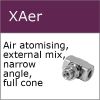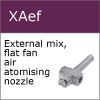Air atomising nozzles for sanitising/ disinfecting
Air atomising nozzles require both fluid and compressed air to operate. They work by mixing the fluid into a fast-moving air stream which serves to atomise the fluid into very fine droplets. Average droplet sizes of between 8 and 40 microns can be achieved with this type of nozzle.
In addition to finely atomised sprays these nozzles have three other features that make them an excellent choice for disinfecting applications:
- They can produce very low flow rates, in some cases below 1 litre per hour. This means that the fine, micro coatings required for disinfecting applications can be applied with minimal wetting.
- The nozzles come with a wide variety of spray pattern types. This means that they can be specified for an equally wide range of disinfection systems. The wide range of choices of spray pattern ensures that optimal spraying can be achieved.
- The air helps distribute the fine spray over a wide area if necessary or, in the case of very targeted spraying, helps keep it on target and avoids drift. This overcomes some of the limitations of hydraulic high-pressure nozzles.
The downside of air atomising nozzles is that they require a compressed air feed and this might not be available in all situations.
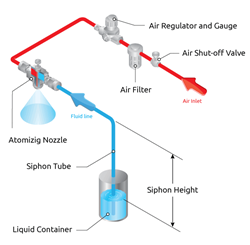 Siphon-fed air atomisers for disinfection
Siphon-fed air atomisers for disinfection
The advantage of these nozzles is that no fluid pump is required. The compressed air passing through the nozzle will generate suction in the fluid inlet which will siphon up the required liquid and entrain it in the airflow. This feature can greatly simplify disinfection system design and avoid the need for costly fluid pumps.
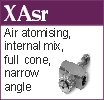
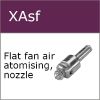
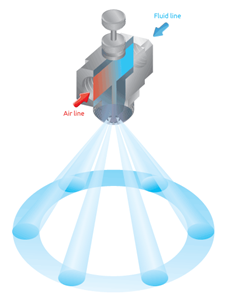 Internal mix atomisers for disinfection
Internal mix atomisers for disinfection
These nozzles mix the air and fluid in the nozzle before ejecting it. This type of air atomiser can achieve the smallest droplet size and has the widest range of spray pattern variants. The disadvantage of the nozzle is that the air and fluid 'compete' to escape from the nozzle orifice. This means that calibrating flow rates is more difficult with often small changes to either fluid or air pressure having quite big effects on the spray. Good fluid and pressure regulation is, therefore, required to ensure a consistent spray.
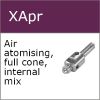
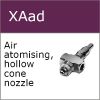
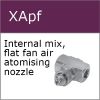
External mix air atomisers for disinfection
 As the name suggests these nozzles mix the air and fluid external to the nozzle orifice. This means that viscous fluids can be atomised, as in an internal mix variant the mixing of viscous fluids and air inside the nozzle causes blockages. External mixing also means that the fluid flow rate is independent of the air pressure. Fluid flow is determined only by the fluid pressure and so can be calibrated and set more easily.
As the name suggests these nozzles mix the air and fluid external to the nozzle orifice. This means that viscous fluids can be atomised, as in an internal mix variant the mixing of viscous fluids and air inside the nozzle causes blockages. External mixing also means that the fluid flow rate is independent of the air pressure. Fluid flow is determined only by the fluid pressure and so can be calibrated and set more easily.
